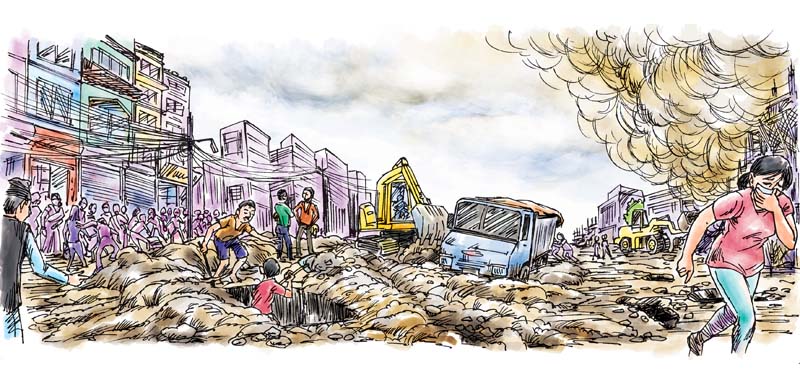TACKLING AIR POLLUTION IN KATHMANDU CITY: LEARNING FROM SUCCESS STORIES OF OTHER CITIES

Kathmandu city has become one of the most polluted cities in the World and Nepal – one of the most polluted countries. While general impression being given by the popular media is that the pollution is a temporary phenomenon caused by Forest fires and lack of rains. Politicians talk about it only during elections as every candidate for Mayor’s position in Kathmandu and Patan last year had promised to control Dhuwa and Dhulo(smoke and dust) on a priority basis. However, the air pollution problem is reaching to a crisis situation. What can be done to control it on a short and long-term basis?
To find a solution, first we have to understand the nature and source of the pollution problem. Kathmandu valley is situated in a bowl-shaped geographic region surrounded by four small to medium height mountains. The Valley is Nepal’s one of the fastest growing urban centers – besides being nation’s capital region). It is one of the most densely populated and developed metropolitan areas. The valley has grown from a mixed rural-urban centers to a fully urban settlement without proper planning and haphazard infrastructure development and industrialization. This has resulted into fast rise in air, water and land pollution. Air pollution is the most visible and serious pollution problem.
Both national and international experts have been raising the issue of worsening air pollution and its impact of public health especially those of children, elderlies and economically vulnerable population. On any average day, the Kathmandu Valley’s air contains five to ten times more pollutants than the amount considered safe by the World Health Organization (WHO).
There are four primary sources of air pollution in Kathmandu valley: transport, industry/brick kilns, solid waste and household biomass energy. The bowl-shaped location of the valley adds to the impact of all the fours sources of pollution. The tall mountain ranges surrounding the valley does not let polluted air to escape due to lack of adequate wind circulation. For example these days polluted air remains suspended in the air for 24 to 36 hours. To compound the problem further, Nepal’s location between India and China means pollutants from both countries flow into Nepal. It is estimated that air pollution is causing massive health, wellbeing and economy of Nepalese people. It is estimated that each year close to 35,000 people in Nepal die due to the intake of contaminated air and the life span of an average Nepalese will be shortened by 5-10 years.
The government has not taken any concrete measures to control air pollution. International agencies especially USAID and ICIMOD has been helping the Govt. of Nepal in in installing and running air pollution monitoring stations both inside and outside the Valley. The government has prepared a National Plan for Electric Mobility (NPEM) that aims to increase the share of electric vehicles to 25% by the end of 2030 in the Valley and 15% in the country. The transition to electric vehicles focuses on air pollution caused by transportation.
Learning from success stories of other countries will help Nepal and international organizations improve the country’s air quality. For example, the city of Bogota – the capital of Colombia in South America is a leader in air pollution control. The city is electrifying its city bus and metro transportation system by 2024 and to reduce and air pollution by 10%. Warsaw, Poland is another city that has launched aggressive air pollution control initiative by installing 165 air sensors and a phase-out plan for coal as a source of energy. It has launched a Breathe Warsaw initiative by joining C40 Clean Air Cities Declaration. Seoul, South Korea is also emerging as a success story in controlling air pollution. Like Kathmandu Seoul also faces high PM2.5 emissions from diesel vehicles. It has therefore decided to ban dieses cars and jeeps by 2025. Seoul has also decided to achieve zero waste by 2040. Another nearby city whose example, Kathmandu can emulate is Bangkok whose traffic jam problems and high pollution levels are well known. However, these problems are gradually becoming things of the past. Bangkok city has launched a number of pollution control initiatives. First, it has greatly expanded its road (including express ways) networks as well as metro networks. In 2019, it launched a bold initiative called Green Bangkok 2030 project that aims to increase the ratio of green space in the city to 10sqm per person. It is planning to have trees and greenery cover 30% of the city’s total area. Eleven new green parks are to be established and 15km greenway is to be constructed to reduce air pollution especially from vehicular transportation.
Kathmandu badly needs greeneries within the city limit and the Valley as a whole has to restore the green belt we had all around the Ring Road. Nepal is a landlocked country and its geographical location means air pollutants are generated locally, nationally and regionally. Therefore regional and international co-operation is necessary to tackle air pollution crisis. One good example of bilateral co-operation is between the Nepalese government and USAID, Nepal. This joint initiative has not only enabled Nepal to monitor its air quality but also take a number of steps to improve air quality. Awareness raising, education of children and general public, institutional capacity building, and coordination and cooperation among the three tiers of governments are key to tackle air pollution not only in Kathmandu valley but also in the entire country.
